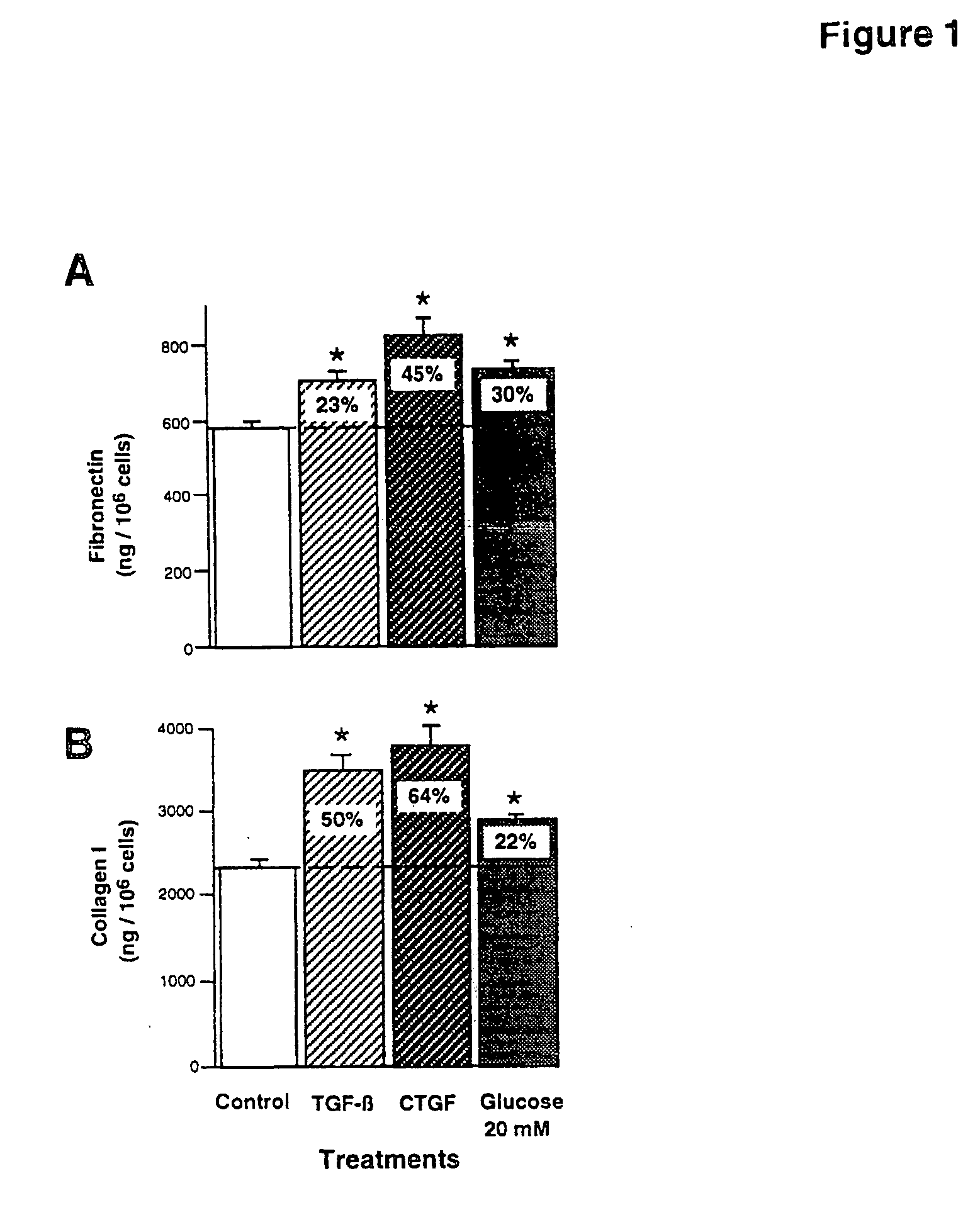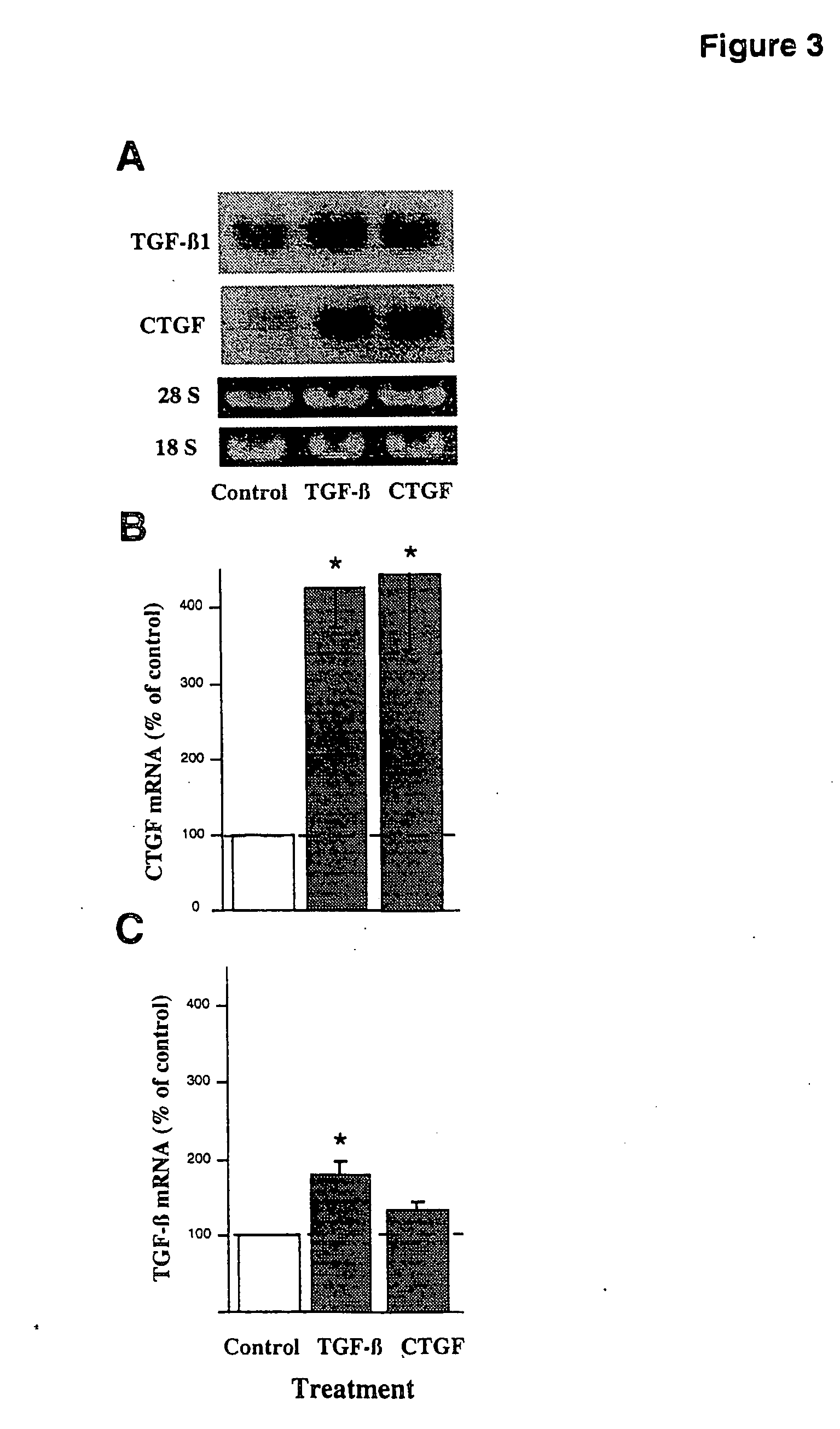Treatment of disorders associated with elevated blood glucose or blood pressure
a technology of connective tissue growth factor and extracellular matrix, which is applied in the direction of drug composition, metabolic disorder, cardiovascular disorder, etc., can solve the problems of body's ability to adequately, degradation or impairment of kidney function, and the inability of the body to meet the needs of the body, so as to reduce the overproduction of extracellular matrix and inhibit the activity of ctgf
- Summary
- Abstract
- Description
- Claims
- Application Information
AI Technical Summary
Benefits of technology
Problems solved by technology
Method used
Image
Examples
example 1
[0172] CTGF-Induced Changes In Extracellular Matrix Production Of Mesangial Cells. To determine the effects of exogenous CTGF on mesangial cell production of the extracellular matrix, serum-depleted cells were exposed for 48 hours to media containing 20 ng / ml of rhCTGF. For comparison purposes, additional cultures were incubated in media without exogenous CTGF, but containing either 2 ng / ml of TGF-β, or 20 mM glucose. As anticipated, exogenous TGF-β and the high glucose concentration increased the amount of secreted fibronectin by 23 and 30%, respectively, over that of controls as shown in FIG. 1A. The presence of exogenous CTGF in the media also effectively stimulated fibronectin secretion by 45%. Like fibronectin, the quantity of secreted collagen type I was also increased by 64% CTGF, as well as by 50% TGF-β or 22% high glucose as shown in FIG. 1B.
example 2
[0173] Renal And Mesangial Cell CTGF Expression: Regulation By TGF-β. It was determined whether cultured rat mesangial cells expressed CTGF mRNA, and the results were compared to those from whole kidney. Northern analysis demonstrated a single 2.4 kb CTGF transcript in mesangial cells and whole kidney, but in contrast no detectable message was evident in cultured kidney fibroblasts as demonstrated in FIG. 2. When compared to other tissues, the most abundant expression was in the kidney, being approximately 20-fold higher than in the brain.
[0174] To determine if TGF-β was a regulatory factor in mesangial cell expression of CTGF message, cells were serum-depleted, exposed to 2 ng / ml of TGF-β for 24 hours, the mRNA was then probed. Changes in TGF-β transcript levels were also monitored. Exogenous TGF-β exposure increased the expression of CTGF mRNA greater than 4-fold as shown in FIG. 3A and FIG. 3B, whereas TGF-β mRNA increased 80% (see FIG. 3A and FIG. 3C). To determine whether CTGF...
example 3
[0176] Detection Of CTGF In Mesangial Cells. The CTGF protein detected In mesangial cell cultures above represents free molecules present in the media. The existence of a heparin binding domain within CTGF suggests that a substantial portion of the synthesized and released protein exists bound to proteoglycans, or to fibronectin, present on the cell surface or in the extracellular matrix. To ascertain whether this was the case, and to determine the time course for appearance of CTGF in the extracellular environment under unstimulated conditions, mesangial cell cultures were serum-deprived and then fresh maintenance media containing 50 μg / ml of sodium heparin was added. Conditioned media were collected after defined incubation periods and the majority of the sample pooled and heparin-sulfate precipitated. Immunoblotting of the 4 hour samples produced faint CTGF bands at approximately 36 and 39 kD (see, FIG. 5A). The intensities of these bands increased sharply by 24 hours and remaine...
PUM
| Property | Measurement | Unit |
|---|---|---|
| Molar density | aaaaa | aaaaa |
| Molar density | aaaaa | aaaaa |
| Elongation | aaaaa | aaaaa |
Abstract
Description
Claims
Application Information
 Login to View More
Login to View More - R&D
- Intellectual Property
- Life Sciences
- Materials
- Tech Scout
- Unparalleled Data Quality
- Higher Quality Content
- 60% Fewer Hallucinations
Browse by: Latest US Patents, China's latest patents, Technical Efficacy Thesaurus, Application Domain, Technology Topic, Popular Technical Reports.
© 2025 PatSnap. All rights reserved.Legal|Privacy policy|Modern Slavery Act Transparency Statement|Sitemap|About US| Contact US: help@patsnap.com



